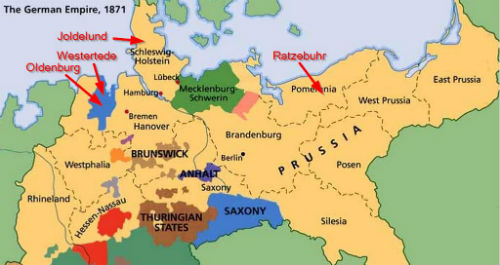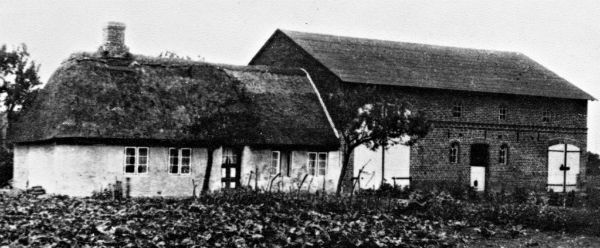Our Great-Grandparents
All of the Oklahoma Brunken Cousin great-grandparents immigrated to the USA from Germany and eventually lived in Nebraska.
- Carsten Petersen Sr. (1849–1921) was born 19 Sep 1849 in Joldelund, Schleswig-Holstein, Denmark. He immigrated in 1869 via New York first to Wisconsin and then to near Columbus, Nebraska.
- Margarete Hollmann (1852–1886), wife of Carsten Petersen, was born 3 Feb 1852 in Oldenburg, Germany. She immigrated with her sister in 1871 via Baltimore to near Columbus, Nebraska.
- Johann “John” Diedrich Brunken (1844–1925) was born 5 Dec 1844 in Westerstede, Oldenburg, Niedersachsen, Germany. He immigrated in 1866 via New York to New Jersey, then moved to near Columbus, Nebraska.
- Johanna Wilhelmina Plath (1853–1949), wife of John Brunken, was born 22 Feb 1853 in Ratzebuhr, Neustettin, Pommern, Prussia. She immigrated in 1870 via New York to New Jersey, then followed her husband to near Columbus, Nebraska.
Ancestral Homes
This 1871 map of Germany points to the ancestral homes of our great-grandparents.

One observation is that our great-grandparent’s ancestral homes were in the north of Germany near Scandinavia.
Ancestral Hometown Histories
A review of the histories of the ancestral hometowns of our great-grandparents finds that over the centuries they were under various state ownership and rulers.
Joldelund, Schleswig-Holstein
Schleswig and Holstein have at different times belonged in part or completely to either Denmark or Germany, or have been virtually independent of both nations. The exception is that Schleswig had never been part of Germany until the Second Schleswig War in 1864. For many centuries, the King of Denmark was both a Danish Duke of Schleswig and a German Duke of Holstein. Essentially, Schleswig was either integrated into Denmark or was a Danish fief, and Holstein was a German fief and once a sovereign state long ago. Both were for several centuries ruled by the kings of Denmark. In 1721, all of Schleswig was united as a single duchy under the king of Denmark. In the church, following the reformation, German was used in the southern part of Schleswig and Danish in the northern part. The administration of both duchies was conducted in German, despite the fact that they were governed from Copenhagen.
The promulgation of a common constitution for Denmark and Schleswig in November 1863 prompted Otto von Bismarck to intervene and Prussia and Austria declared war on Denmark. This was the Second War of Schleswig, which ended in Danish defeat and Denmark lost Schleswig (Northern and Southern Schleswig), Holstein, and Lauenburg to Prussia and Austria. After the annexation of Schleswig-Holstein by Prussia, a country parish was formed from the area of the parish Joldelund. It included the four villages Goldebek, Goldelund, Joldelund and Kolkerheide .
The northernmost part and west coast of the province saw a wave of emigration to America, while some Danes of North Schleswig emigrated to Denmark. It was at this time that Carsten Petersen immigrated to the USA. According to family lore, Carsten always considered himself to be Danish even though he officially emigrated from Germany.
(Derived from Wikipedia at https://en.wikipedia.org/wiki/Schleswig-Holstein)
Oldenburg
Oldenburg is an independent city in the district of Oldenburg and became the capital of the County of Oldenburg (later Duchy, Grand Duchy, and Free State), a small state in the shadow of the much more powerful Hanseatic city of Bremen. The earliest recorded inhabitants of the region now called Oldenburg were a Teutonic people – the Chauci. The genealogy of the counts of Oldenburg can be traced to the Saxon hero Widukind (opponent of Charlemagne). The Free Hanseatic City of Bremen and the bishop of Münster frequently warred with the counts of Oldenburg. In 1448, the son and heir of Count Dietrich (died 1440), named Christian but called Fortunatus, became king of Denmark as Christian I. In 1450, Christian became king of Norway and in 1457 king of Sweden. In 1773 Danish rule ended and, in 1774, the Oldenburg region became a duchy. During the French annexation (1811–1813) in the wake of the Napoleonic war against Britain, it was also known as Le Vieux-Bourg.
(Derived from Wikipedia at https://en.wikipedia.org/wiki/Oldenburg)
Westerstede, Oldenburg
Westerstede was an administrative district of the Grand Duchy of Oldenburg and the later Free State of Oldenburg. Finds of hand axes, stone axes and scrapers prove that today’s Westerstedes was settled early. In the 15th and 16th centuries Westerstede and the surrounding villages often suffered from the warlike feuds between the Oldenburg counts and the East Frisian chieftains for supremacy in Nord Oldenburg. During the Thirty Years’ War, the county Oldenburg and thus Westerstede were largely spared, as the ruler, Count Anton Günther, by wise policy and gifts of noble horses from his famous breed to the generals, the fighting and plundering armies were outside the borders of his country. In 1811, the French occupied the Duchy of Oldenburg, and Westerstede had Napoleon as sovereign. In 1813, this foreign rule ended:
(Derived from Wikipedia at https://de.wikipedia.org/wiki/Westerstede)
Ratzebuhr, Pommern
The Duke Barnim IX. von Pommern-Stettin gave the order in 1554 to settle in the extreme southeast of his territory on the border with Poland. After Pomerania had come under Brandenburg rule in 1653, Ratzebuhr was administratively subordinate to the Neustettinschen circle. In 1656, Poland invaded the region, but were repulsed. During the Seven Years’ War in 1758, Russian troops marched, plundering through the city. Ratzebuhr is now Okonek, Poland. After World War II the region was placed under Polish administration by the Potsdam Agreement as a part of territorial changes demanded by the Soviet Union. Most Germans fled or were expelled and replaced with Poles expelled from the Polish areas annexed by the Soviet Union.
(Derived from Wikipedia at https://de.wikipedia.org/wiki/Okonek)
Carsten Petersen, Sr. Childhood Home
“Carsten Petersen, Sr., … was born in Schleswig-Holstein, Germany, near Bredstedt[2], September 19, 1849, a son of Carsten and Anna. K (Jacobson) Petersen, in whose family were five children, of whom the subject of this review is the third in order of birth. The father followed farming and thus provided a comfortable living for his family.”[3] A note on the back of the following picture, states that this was the Petersen family home where Carsten Petersen was born and raised in Denmark (Now Germany) before he immigrated to the United States in 1869.

- WHEN: DateUnknown
- WHERE: Schleswig-Holstein, Germany – near Bredstedt[2]
- SOURCE: Evelyn Brunken
- NOTES:
- The photograph of Carsten Petersen, Sr. Childhood Home was framed by Evelyn’s son, Alan Brunken, and was displayed on the living room wall of Aunt Evelyn’s home.
- “Bredstedt (Low German: Bredstedt; Danish: Bredsted; North Frisian: Braist) is a town in the district of Nordfriesland, in Schleswig-Holstein, Germany. It is situated near the North Sea coast, approximately 20 km northwest of Husum.” Downloaded 20 Sep 2014 from http://en.wikipedia.org/wiki/Bredstedt.
- Phillips, G. W. “Past and Present of Platte County Nebraska – A Record of Settlement, Organization, Progress and Achievement” Vol II p 439. – CARSTEN PETERSEN, SR.
